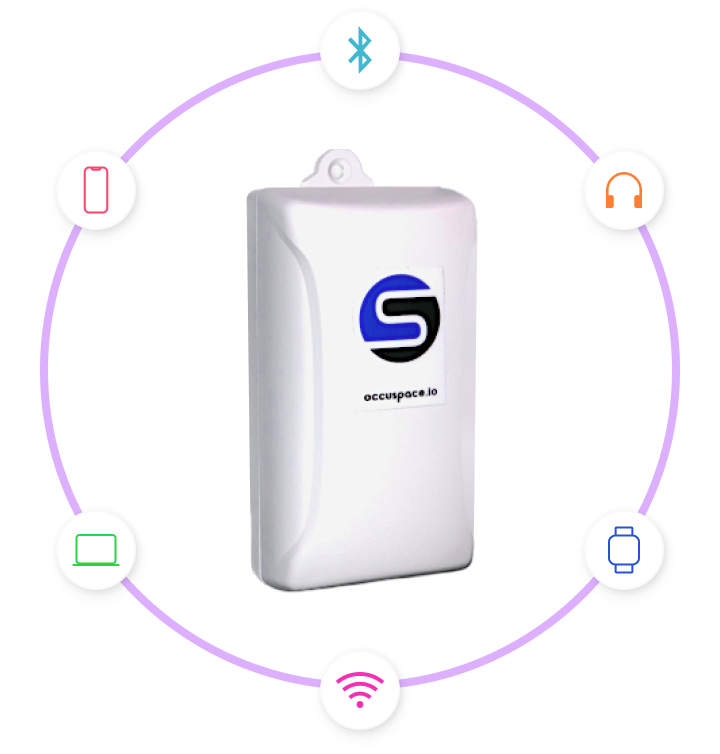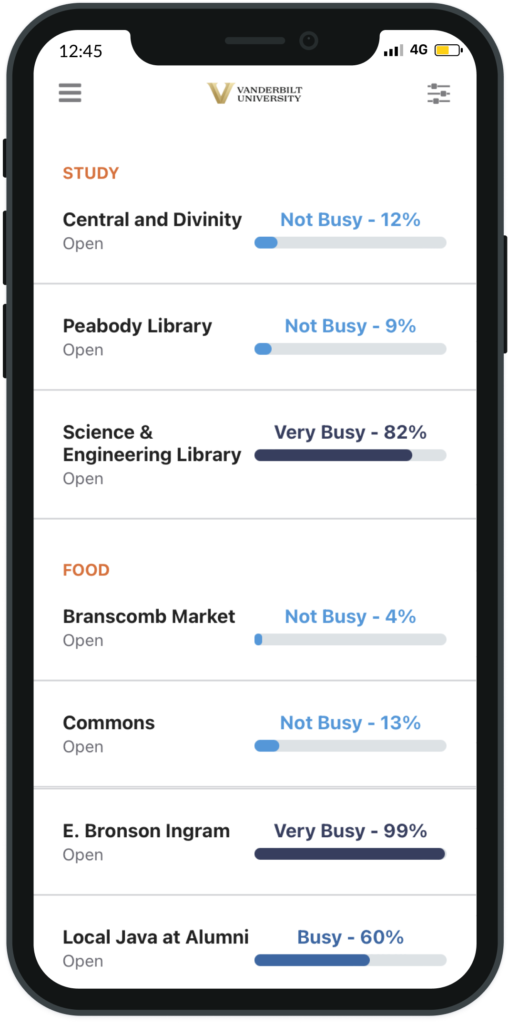Vienna Parnell | October 20, 2022
Food that’s worth the “Waitz”?: An interview with Nic Halverson, the founder and CEO behind the crowd level tracking software installed in Vanderbilt’s dining halls
Lines of backpack-clad students cluttering the walkways, lively chatter and laughter, the clatter of countless dishes and food scraps, and not a single vacant seat in sight—just signs of a typical weekday at Vanderbilt’s Rand Dining Hall.
With its proximity to many academic buildings and a wide variety of dietary options, Rand is often the go-to spot for hungry students finishing their morning classes. The dining hall is notorious for its lunchtime rush, long wait times, and inadequate seating despite the additional second-floor tables.

Fortunately, there is a way for students to check the occupancy of public spaces ahead of time thanks to Occuspace, the creator of privacy-friendly occupancy monitoring sensors and the free mobile app, Waitz. As of last month, students have been able to download this service, which allows users to check in live-time how busy a dining hall is on a percentage scale. Currently, the app is available on iOS and Android and supports a total of twelve Vanderbilt locations—three libraries and nine dining options.
Occuspace is a San Diego start-up aimed at facilitating optimal space utilization and founded in 2017 by Nic Halverson. I had the opportunity to interview Halverson, and we discussed his motivations for pursuing the start-up, the process of developing and testing the crowd tracking algorithms for accuracy, and his aspirations for Occuspace.

Halverson’s experiences as an undergraduate were akin to those of many Vanderbilt students heading to Rand for lunch. Struggling to find a seat in UC San Diego’s Geisel Library to study one night, he wished that there was a practical way of knowing the occupancy of each floor before he arrived—the idea that would eventually result in the creation of the Waitz app.
With the support of his university’s incubator program and almost six thousand downloads on the first day through the participation of UCSD students, Halverson persevered through the initial stages of beginning a start-up. To achieve the presence and reliability that Occuspace has today, however, took years of trial and error and a careful understanding of the inner workings of IoT sensors.
Occuspace provides real-time data by using Internet of Things (IoT) sensors to scan for Bluetooth and Wifi signals. Internet of Things refers to the interactions and exchange of data between software and physical devices; for the purposes of crowd tracking software, this entails detecting radio signals that are emitted by devices that are on a user, including smartphones, wearable electronics, and computers. By detecting the number of MAC addresses, unique identifiers for each device, an estimate of the individuals in the room can be made. Occuspace also claims that privacy protections involving encryption and hashing of the MAC addresses are in place to prevent personal information from being leaked.
Crowd tracking is not always straightforward, especially in practical real-world situations. For instance, many students at Vanderbilt have multiple devices on them at all times, such as a phone, laptop, smartwatch, and tablet for note-taking. Halverson acknowledges this variability and explains the subsequent need for developing precise algorithms: “It’s really hard to understand that these signals are one person and then these six signals that walk in right after also one person. But we have over 20 different variables that go into our algorithms… The first thing we do is have really, really good filtering algorithms… And then we look at a lot of different characteristics about how the signals are moving in this space, how tightly they’re positioned against each other, and a variety of other factors.”
Through this approach, Occuspace technology achieves tracking accuracy in the range of 80-95%. This statistic is calculated using data that the company’s customers provide across a total headcount of over 14,000; the observed number of people is compared to the occupancy that the installed software predicts, and the accuracy is extrapolated. The reason for the range in data relates mainly to the size of the room. Halverson explains, “Overall, today, we’re at about 93% accuracy. It really depends on the space. Some spaces, smaller spaces, we might be 85% accurate, and maybe in some spaces that are really big, we’re gonna be 98%.”
Occuspace technology is also helpful beyond the convenience of allowing students to receive food more quickly; it also has implications on student health. After all, high concentrations of people eating and conversing in tight spaces still runs the risk of spreading contagious diseases in the face of COVID-19. The pandemic introduced new, rewarding opportunities for Halverson to work with clients interested in reducing overcrowding health concerns: “It was cool to see our technology able to help in a time of need where a lot of people were, you know, frankly, pretty scared and, and didn’t really know what was going on.”
In addition to teaming up with universities, Occuspace has engaged in partnerships with corporations in the tech industry. Halverson recalls that many businesses reach out with concerns along the lines of, “‘We spend a billion a year on construction, renovation, and leases, and we have no data on how our buildings are actually being used.’”
Occupancy data has a key role in space efficiency and ensuring that companies are wisely spending their funds on resources at a meaningful scale, especially as employees transition from remote work to on-site and vice versa. As Halverson notes, “The average office space is only 30 to percent full during the workday, and so people have been wanting to make real estate more efficient. They’ve been wanting to bring analytics into the real world for a long time. There just hasn’t been affordable, installable solutions to do it.”
On a personal level, Halverson finds meaning both in his interactions with customers but also with his team, enjoying the process of “being able to build a group of people that you work with really go battle with you every day and make it become a reality.” Though he has already worked extensively with both universities including Vanderbilt and businesses, Halverson also has aspirations in other areas. “In the long term, I get really excited about what we can do in the retail world,” he describes. “What if we’re a small retail store, how can […] I make improvements to that store so the customers have a better experience? Our staff food waste schedule, our batch cooking, we have better conversion rates, […] I think we can really change the experience around retail.”
Halverson might not be a student in university himself anymore, but he hopes to enjoy the benefits of Occuspace technology as a frequent guest at many popular restaurant chains: “My number one goal is that all of these different retail stores, whether it’s Starbucks, Chipotle, or the grocery store, they actually tell customers how busy they’re before they get there.”
The future of occupancy tracking technology outside of the university setting is exciting and promising but in the meantime, Vanderbilt students can count on the Waitz app for avoiding dining hall and library crowds. Perhaps one day one of your classmates or even you, like Halverson, will go on to pursue an innovative startup that will improve and inspire your own community.
Bibliography
FAQ. Waitz. [accessed 2022 Oct 4]. https://waitz.io/faq.html
Freeman M. San Diego start-up helps college students avoid crowds on campus amid pandemic. Tribune. 2020 Sep 24 [accessed 2022 Oct 4]. https://www.sandiegouniontribune.com/business/technology/story/2020-09-24/san-diego-start-up-helps-college-students-avoid-crowds-on-campus-amid-pandemic
Marketing VCand. Campus dining, libraries launch new capacity-monitoring system to improve student experience. Vanderbilt University. 1970 Sep 8 [accessed 2022 Oct 4]. https://news.vanderbilt.edu/2022/09/08/campus-dining-libraries-launch-new-capacity-monitoring-system-to-improve-student-experience/
Occuspace. [accessed 2022 Oct 16]. https://occuspace.io/
Parnell V, Halverson N. Interview with Mr. Halverson. 2022. https://docs.google.com/document/d/110t3sD1KQE3NcnvwQNJ4uArglH8Wste5T2FyAZg7fNI/edit?usp=sharing.
Vanderbilt University. Waitz. [accessed 2022 Oct 16]. http://waitz.io/vanderbilt/